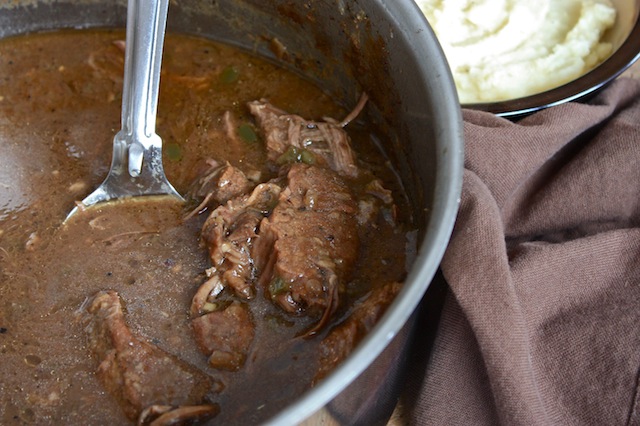
Roast Beef
When I prepare roast beef, I start with the largest chuck roast I can find. I look for a six or seven pounder. If I can’t get my hands on one that size, I buy two smaller roasts that total about the same. Why so much you ask for my family of five? Well, in this house, roast beef is a cook once, eat thrice proposition! No ifs, ands or buts! That first meal is always a traditional roast dinner complete with Baked Mashed Potatoes and something green. The leftovers are then repurposed–in the best way–for roast beef poor boys. And then whatever lingers, usually a very meaty gravy affectionately referred to in New Orleans as “debris,” is reserved for stuffing pasta shells or topping baked potatoes.
The cut of beef I use for this fabulous threesome (get your mind out of the gutter) is a matter of personal preference and one tied directly to my favorite style of roast beef poor boy–the “pot roast variety.” You see, this style of roast beef poor boy (as opposed to its sliced beef counterpart) is best achieved with chuck. Yeah, he’s a bit tough around the edges. But once he’s seasoned up and allowed to relax in a hot tub of lovely liquids, his softer side emerges and he is transformed into an unbelievably fork-tender and richly flavored specimen of meat. That meat is then effortlessly pulled apart or cut into mouthwatering chunks and laid to rest between two pillowy slices of New Orleans-style French bread. At the same time, the fat and connective tissue that gives chuck his brawny reputation melts into the braising liquid to create a thick, intensely flavored gravy–another integral part of this whole roast beef dinner/poor boy equation. If you happen to be the sliced-roast-beef-poor-boy-type, than chuck is not your man. For that style, you’ll need to buddy up to an inside round, bottom round or eye of the round. Those are the cuts that, when cooked and chilled, will slice up nicely. But that’s another post for another day. Oh, and in case you’re wondering, the “roast” in roast beef actually refers to the cut of meat (beef chuck roast, beef eye of the round roast, etc.) and not the cooking method. The beef that ends up on poor boys, real roast beef poor boys, is actually braised and not roasted. That’s the technique that keeps the meat moist and flavorful.
Roast Beef Recipe
Seasoning Mix
1 1/2 teaspoons kosher salt
1 teaspoon garlic powder
1 teaspoon onion powder
1/2 teaspoon black pepper
1/2 teaspoon cayenne pepper
1/2 teaspoon white pepper
1 5- to 7-pound bone-in beef chuck roast
8 garlic cloves (6 peeled and sliced in half; 2 minced), divided
1/2 cup canola oil
4 tablespoons butter
1/2 cup all purpose flour
1 cup chopped onions
1/2 cup chopped green bell peppers
1/4 cup chopped celery
2 cups beef stock (or beef broth enriched with 1 teaspoon beef base)
2 tablespoons Lea & Perrins (Worcestershire sauce)
2 bay leaves
Salt and pepper to taste
Preheat oven to 325 degrees. In a small bowl, thoroughly combine seasoning mix; set aside. Using a sharp knife, make 12 small slits about 1 1/2 inches deep all over roast. Using your fingers, plug a slice of garlic into each slit. Rub roast with seasoning mix. Heat oil and butter in a large Dutch oven over medium-high heat. Once the butter melts, add roast and sear until crusty brown on all sides, about 4-6 minutes for each large side. Transfer roast to a platter. Make a roux by adding the flour to the oil and brown bits left in the pot. Whisk constantly until the roux is the color of milk chocolate. Add onions, bell peppers and celery; cook, stirring frequently, until tender, 3-5 minutes. Add minced garlic; cook 2 minutes more. Gradually stir in beef stock or enriched beef broth; bring to a boil. Remove from heat and stir in Lea & Perrins, bay leaves and salt and pepper to taste. Return roast to pot, cover tightly and place in oven. Braise the chuck roast, turning occasionally, until meat is very tender, 4 to 5 hours. Remove roast to a cutting board and pull meat apart with two forks; discard fat and bones. Remove bay leaves from gravy; discard. Skim any fat that rises to the top of the gravy. Add meat back to gravy; serve warm. Makes 6 servings (with leftovers for poor boys).
Genêt



